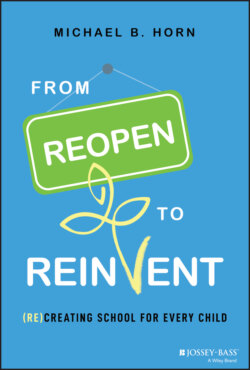Читать книгу From Reopen to Reinvent - Michael B. Horn - Страница 14
Introduction
ОглавлениеIn the wake of the COVID-19 pandemic shattering the routines and lives of students, parents, and educators, schools have been through so much.
In the Boston Globe, Sarah Carr told the story of 10-year-old “Daniel”—his middle name to protect his identity. A struggling reader who is dyslexic, Daniel had finally gotten the support he needed from his school district after six years of effort by his parents.
Yet when schools shut down in March 2020, the support stopped—the tutoring, small-group classes, and specific teaching interventions.
Daniel's heartbreaking story was far from unusual, as COVID-19 interrupted schools' operations across the world.
But schools were struggling before the pandemic as well.
Most of these challenges weren't of any one person's making, nor were they the fault of the people who work in schools today. Many of the challenges were the result of structures and processes that were designed long ago for a different age. These structures have become stuck in our world as “the grammar of schooling” or “just the way school is.”
That students start kindergarten fascinated by schooling and end up bored isn't a coincidence. It's the logical outgrowth of how our schools are built. For decades, it was a successful design.
But in today's knowledge economy that prizes intellectual capital—where we need all individuals to build passions and develop their full human potential—it no longer suffices.
Amid the disaster since the pandemic's assault on society and schools over multiple school years, there is opportunity to rebuild better by altering the fundamental assumptions undergirding our present-day schooling model.
Despite my background, this isn't a book about disruptive innovation.
Nor is it a book about the devastation and disruption that the pandemic caused.
It's about what we build out of this devastation. What we choose to create.
It starts with educators.
Although there are many obstacles over which educators have little control, this is a book for administrators, teachers, and those communities involved in schools—parents and school boards—to help them reconceive what they are trying to accomplish and create a more supportive model that allows them to better serve each child. For parents frustrated with the challenges their children have faced at schools, the book presents a path forward from the pandemic.
It's also a book for policymakers and voters to help them rethink what is standing in the way of building better learning opportunities for all individuals.
The idea of this book is to shift us from seeing the pandemic as a giant threat to also viewing it as an opportunity. An opportunity to overthrow an education system that's not working as well as it could for anyone—certainly not for low-income students. Certainly not for far too many boys and girls who are judged by the color of their skin rather than for their vast potential. Nor is it working for wealthy and privileged children in our society, despite popular perception.
